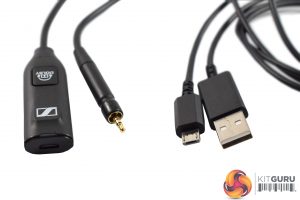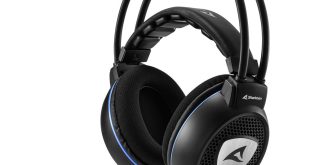To test the GSP 350, I used it for a couple of weeks. During this time, I used it primarily while gaming, but also while listening to music and watching videos.
Let's start with a look at the software:
The GSP 350 software is very basic and covers just three areas – EQ, mic noise reduction and mic sidetone. The EQ tab only gives you a choice between three pre-configured presets, or ‘off', which is certainly not very sophisticated. I would have much preferred a graphic EQ to give users finer control over the sound.
Still, software is only a minor part of the headset, so let's talk about what it is like using the GSP 350 on a day-to-day basis.
Starting with comfort, I immediately noticed that I had to adjust the headset to its largest size, which is very unusual for me as I typically only make small adjustments to the size of each headset that I review. If I had the GSP 350 any tighter, it simply was not comfortable and the ear cups would not fit around my ears. This does concern me as my head is really far from large – I would describe its size as ‘very average', so I do worry that those with heads at the larger end of the spectrum may simply be unable to wear this headset.
That aside, the padded headband is nice and soft, while the ear cushions fit around my ears very well. I am not too happy with the faux-leather ear cushions, though, as I find I get very hot while using faux-leather cushions. Ideally, considering the price, Sennheiser should have given end-users the option by having a second pair of cushions included in the box, but that is sadly not the case here.
However, when we get to sound quality, things do pick up. The GSP 350 is probably one of the best-sounding headsets I have used over the years, for multiple reasons.
I'll start with the bass, as it is definitely present and hard to miss – unlike the Sennheiser Game Zero headset that I have used, which is very light on the bass. Not with the GSP 350, though – the low-end is punchy and tight, but still very well contained, meaning it does not spill over and ‘muddy up' the mids or highs.
Those mids are also quite full and rich, while the treble is similarly crisp and adds a lot of detail when compared to other gaming headsets. When gaming, all of that creates a very enjoyable sound – the bass gives impact to explosions and gunfire, while the mids and highs are still there to allow you to hear your teammates and pick out footsteps.
Moving on, we must discuss the virtual 7.1 surround as this is a big reason to go for the GSP 350 over its little brother, the GSP 300. With that in mind, I dived into titles like Star Wars Battlefront and Ghost Recon: Wildlands to see what the virtual surround is like. Unfortunately, it is not a very good implementation of virtual 7.1 as the sound immediately loses all clarity and becomes a jumbled mess of reverb and slight distortion. This is definitely unfortunate as the surround-sound is perhaps the biggest difference between the GSP 350 and the GSP 300, so the fact that it is pretty poor makes the GSP 350 a tough sell given its increased cost.
Elsewhere, I must also touch on the mic. I tried using the mic with noise cancelling on and off, and overall I feel that the quality is much improved with the noise cancelling turned off. This is because the noise cancelling algorithm just clips the ends of the words you speak, meaning speech sounds a bit unnatural and almost jilted. Everything sounds more natural and less robotic with the technology turned off, though more background noise does come through.
So, while the mic quality is definitely good – if not incredibly amazing – it is incredibly quiet. This is something we initially mentioned in our GSP 300 review, and it does not seem to have changed. Recording myself talking at a normal volume, with the mic level set to 100 in Windows, resulted in a clip that was barely audible – even when I turned the headset volume up to the max. While gaming I may as well have not been there as my team mates really struggled to hear me. Overall, this is a poor show from Sennheiser and something that needs immediate rectification.
My last point of criticism is the cable situation. The GSP 300 uses standard 3.5mm jacks with a y-splitter included, and can therefore be used on multiple platforms – consoles, PC, laptops, smartphones, whatever. Unfortunately, for the GSP 350, Sennheiser decided to implement two cables (above), with one going from the headset to the surround-sound dongle, and another from the dongle to your PC. This means you can't use the headset with anything other than a PC – as there is no 3.5mm jack to be seen. Clearly, this must've been done to allow for the 7.1 dongle, but there is still no need to completely remove support for other devices.
What Sennheiser should have done – and what HyperX did with its Cloud Revolver S – is to first use a cable which ends in a 3.5mm jack, and have that connect to the 7.1 dongle, instead of having the dongle on the end of the first cable. That way, users can still get virtual surround-sound without losing the ability to use the headset with their phone or games console.
Be sure to check out our sponsors store EKWB here
 KitGuru KitGuru.net – Tech News | Hardware News | Hardware Reviews | IOS | Mobile | Gaming | Graphics Cards
KitGuru KitGuru.net – Tech News | Hardware News | Hardware Reviews | IOS | Mobile | Gaming | Graphics Cards






